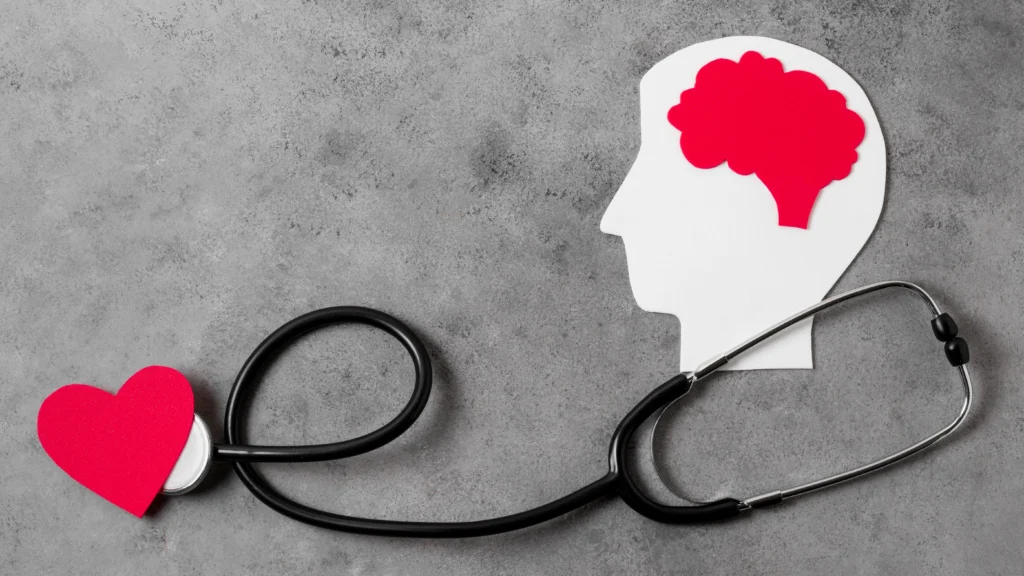Did you know that approximately 1 in 40 U.S. adults and 1 in 100 U.S. children have Obsessive-Compulsive Disorder (OCD), affecting over three million Americans? Despite its prevalence, OCD is often misunderstood as merely being about cleanliness and organization.
In reality, OCD is a complex mental health condition characterized by recurring unwanted thoughts (obsessions) and repetitive behaviors (compulsions) that significantly impact daily functioning and cause considerable anxiety.
These distressing thoughts and behaviors interfere with normal life activities, affecting people’s daily lives in profound ways. This article aims to explore the reality of OCD beyond common stereotypes, examining its various manifestations, causes, and treatment options, providing a clearer understanding of this often-misunderstood disorder.
Key Takeaways
- OCD is a complex mental health condition, not just about cleanliness or organization.
- It affects over three million Americans, including adults and children.
- Recurring unwanted thoughts and repetitive behaviors are hallmarks of OCD.
- OCD causes significant anxiety and interferes with daily life.
- This article explores the reality of OCD, its manifestations, causes, and treatments.
The Common Misconception About OCD
OCD is frequently misrepresented in popular culture, leading to widespread misconceptions about the disorder. Many people view OCD as merely being about cleanliness or organization, but this is a narrow and inaccurate representation.
How Media Portrays OCD
The media often portrays individuals with Obsessive-Compulsive Disorder (OCD) as being excessively neat or having a quirky personality. This portrayal is not only inaccurate but also trivializes the condition. For instance, characters in TV shows or movies are sometimes depicted as having OCD because they are meticulous or have a preference for order. However, this depiction fails to capture the complexity and severity of the disorder.
- OCD is characterized by unwanted, intrusive obsessions that cause significant anxiety and distress.
- The disorder is not just about preferences for order or cleanliness; it’s a clinically recognized condition that impairs daily functioning.
The Reality Behind the Stereotype
In reality, OCD encompasses a wide range of symptoms beyond cleaning or organizing. Individuals with OCD may experience various obsessions and compulsions that are time-consuming and cause significant distress. For example, some may have intrusive thoughts about harm or engage in mental compulsions to alleviate their anxiety. The diagnostic criteria for OCD require that these symptoms be present for more than an hour a day and cause significant impairment in daily life.
Understanding the true nature of Obsessive-Compulsive Disorder is crucial for reducing stigma and promoting awareness. By recognizing the complexity of OCD symptoms and the distress they cause, we can work towards creating a more supportive environment for those affected.
Understanding Obsessive Compulsive Disorder
Understanding Obsessive Compulsive Disorder (OCD) requires a deep dive into its complexities and how it impacts daily life. To grasp what OCD entails, it’s essential to explore its definition, prevalence, and the cycle that characterizes this condition.
Definition and Prevalence
Obsessive Compulsive Disorder (OCD) is a mental health condition marked by recurring, unwanted thoughts (obsessions) and repetitive behaviors (compulsions) that an individual feels driven to perform. These obsessions and compulsions can significantly interfere with a person’s daily activities, social interactions, and overall quality of life. OCD affects approximately 1-2% of the global population, making it a significant mental health concern worldwide.
The prevalence of OCD is observed across different cultures and age groups, indicating its widespread impact. Understanding that OCD is not just about being meticulous or clean, but a serious condition, is crucial for fostering empathy and support for those affected.
The OCD Cycle Explained
The OCD cycle is a vicious loop that involves intrusive thoughts or images (obsessions) that trigger anxiety or distress. In response to this anxiety, individuals often engage in compulsive behaviors or mental acts aimed at reducing their distress. While these compulsions may provide temporary relief, they ultimately reinforce the OCD cycle over time.
- Intrusive thoughts or images (obsessions) lead to anxiety or distress.
- Compulsive behaviors or mental acts are performed to alleviate the anxiety.
- Temporary relief is achieved, but it reinforces the cycle.
- Avoidance behaviors may also become part of the cycle as individuals try to evade triggers.
Understanding this cycle is key to recognizing the challenges faced by individuals with OCD and the importance of seeking appropriate treatment to break this cycle.
The Many Faces of Obsessions
OCD is characterized by a variety of obsessions, which are intrusive thoughts, images, or urges that cause significant distress. These obsessions can take many forms, making OCD a complex and heterogeneous condition.
Understanding the different types of obsessions is crucial for diagnosing and treating OCD effectively. The diversity of obsessions means that individuals with OCD may experience a wide range of symptoms, from fears of contamination to intrusive thoughts about harm.
Contamination Fears
One of the most common types of obsessions is contamination fears. Individuals with these obsessions often fear coming into contact with germs, dirt, or other contaminants that could cause illness or harm. This fear can lead to excessive cleaning or avoidance of situations where they might be exposed to contaminants.
Symmetry and Ordering Obsessions
Some people with OCD experience symmetry and ordering obsessions, where they feel compelled to arrange objects in a specific way or follow a strict routine. This need for symmetry can be so strong that it interferes with daily activities and causes significant distress.
Forbidden or Taboo Thoughts
Forbidden or taboo thoughts are another type of obsession experienced by individuals with OCD. These thoughts can be disturbing or intrusive and often involve themes that are considered socially unacceptable or morally reprehensible.
Harm-Related Obsessions
Harm-related obsessions involve intrusive thoughts about potentially causing harm to oneself or others, either accidentally or deliberately. These obsessions can include fears of acting on violent impulses, accidentally causing accidents, or being responsible for terrible events. Individuals with harm-related OCD often exhibit checking compulsions or avoidance behaviors to mitigate these fears. It’s essential to note that people with harm-related OCD are not at a higher risk of acting violently; they are distressed by these thoughts because they contradict their true nature.
| Type of Obsession | Description | Common Compulsions |
|---|---|---|
| Contamination Fears | Fear of germs, dirt, or contaminants | Excessive cleaning, avoidance |
| Symmetry and Ordering | Need for symmetry or order | Arranging objects, following routines |
| Forbidden or Taboo Thoughts | Intrusive, disturbing thoughts | Mental compulsions, avoidance |
| Harm-Related Obsessions | Fears of causing harm | Checking, avoidance |
In conclusion, the many faces of obsessions in OCD highlight the complexity of this disorder. By understanding the different types of obsessions and their impact on individuals, we can better approach diagnosis and treatment.
Beyond Handwashing: The Spectrum of Compulsions
Compulsions in OCD are not limited to handwashing; they can take many forms that significantly impact daily life. While handwashing is a common compulsion, individuals with OCD may experience a range of other compulsive behaviors aimed at reducing anxiety.
Checking Behaviors
One common type of compulsion is checking behavior, where a person repeatedly checks things like locks, appliances, or the stove to ensure safety or prevent harm. This can be time-consuming and interfere with daily routines.
Mental Compulsions
Mental compulsions involve internal rituals that are not visible to others. These can include mental counting, repeating certain phrases, or praying. Such compulsions can be just as distressing as physical ones.
Ordering and Arranging
Some individuals with OCD may experience compulsions related to ordering and arranging objects in a specific way. This can be driven by a need for symmetry or a fear that disorder will lead to harm.
Reassurance Seeking
Reassurance seeking is another common compulsion, where a person repeatedly asks for confirmation that everything is okay or that they haven’t made a mistake. This can strain relationships as they seek constant help from family, friends, or professionals. Reassurance provides only temporary relief before doubt creeps back in, creating a cycle of needing more frequent reassurance. Digital reassurance seeking is also common, involving researching symptoms online or checking social media for confirmation. While seeking help and support is healthy, compulsive reassurance seeking reinforces OCD patterns.
Primarily Obsessional OCD: When Compulsions Are Not Visible
You might be familiar with the common stereotypes surrounding OCD, but primarily obsessional OCD challenges these preconceived notions. Primarily obsessional OCD, often referred to as “Pure O,” is a subtype of Obsessive Compulsive Disorder where individuals experience obsessions without visible compulsions.
Pure O: A Misunderstood Manifestation
“Pure O” is characterized by intrusive thoughts, urges, or images that cause significant distress. Unlike the stereotypical OCD behaviors, individuals with Pure O may not exhibit outward signs of compulsions. Instead, they engage in mental rituals to cope with their anxiety.
These mental compulsions can include thought neutralization, mental reviewing, or internal counting. For instance, someone with Pure O might repetitively count to a certain number in their mind to neutralize an intrusive thought.
Mental Rituals and Avoidance
Mental rituals and avoidance behaviors play a crucial role in Pure O. Individuals may avoid situations or stimuli that trigger their obsessions, significantly impacting their daily lives. For example, someone with a fear of harming others might avoid being near sharp objects or being alone with children.
These invisible compulsions can be just as debilitating as visible ones, causing significant distress and impairment. Recognizing these mental rituals is crucial for proper diagnosis and treatment of OCD.
| Mental Rituals | Description | Example |
|---|---|---|
| Thought Neutralization | Mentally counteracting an intrusive thought | Repeating a “good” thought to cancel out a “bad” one |
| Mental Reviewing | Repeatedly mentally replaying a past event | Replaying a conversation to ensure it didn’t contain something offensive |
| Internal Counting | Counting to a specific number to reduce anxiety | Counting to 7 or a multiple thereof to feel safe |
The Impact of OCD on Daily Life
The presence of OCD can be felt across different facets of life, from personal relationships to professional endeavors. Obsessive Compulsive Disorder can significantly alter the way a person interacts with others and goes about their daily routines.
Social and Occupational Functioning
OCD can limit social activities and affect occupational functioning. Individuals with OCD might avoid certain social situations or work-related tasks due to their obsessions or compulsions. For instance, someone with contamination fears might avoid shaking hands or touching common surfaces, potentially impacting their professional and social interactions.
This avoidance can lead to feelings of isolation and can impact job performance. Effective management of OCD is crucial to maintaining healthy social and occupational functioning. Education and awareness about OCD can help others understand the challenges faced by those with the disorder.
Relationships and Family Dynamics
OCD can also strain relationships when family members become involved in accommodating rituals or providing reassurance. This phenomenon, known as family accommodation, can unintentionally reinforce OCD symptoms. For example, a family member might adjust their daily routine to help the individual with OCD complete their compulsions, potentially creating tension within the family.
Open communication, education about the disorder, and family therapy can help improve relationships affected by OCD. By understanding the nature of OCD and its impact on family dynamics, loved ones can provide more effective support. This support is crucial for both the person with OCD and their family members, as it can alleviate some of the emotional burden associated with the disorder.
What Causes Obsessive Compulsive Disorder?
OCD is not the result of a single cause, but rather a combination of biological, genetic, and environmental influences. Understanding these factors can help you better grasp how OCD develops and how it can be managed.
Biological Factors
Research suggests that biological factors play a significant role in the development of OCD. Studies have shown that individuals with OCD often have differences in brain structure and function, particularly in regions related to emotional regulation and response inhibition. For instance, abnormalities in the orbitofrontal cortex and anterior cingulate cortex have been linked to OCD symptoms.
Genetic Influences
Genetic influences are another crucial factor in the development of OCD. Individuals with a family history of OCD are more likely to develop the disorder, suggesting a hereditary component. Research has identified several genes that may contribute to the risk of developing OCD, although the exact genetic mechanisms are still being studied.
Environmental Triggers
Environmental triggers can also play a significant role in triggering or worsening OCD symptoms. Stressful life events, childhood trauma, and certain infections have been linked to the onset or exacerbation of OCD. For example, streptococcal infections in children have been associated with the sudden onset of OCD symptoms, a condition known as PANDAS/PANS.
| Trigger | Description | Impact on OCD |
|---|---|---|
| Stressful Life Events | Major life changes or stressors | Can trigger or worsen OCD symptoms |
| Childhood Trauma | Adverse experiences during childhood | Increases vulnerability to developing OCD |
| Infections | Streptococcal infections (PANDAS/PANS) | Linked to sudden-onset OCD in children |
Understanding these factors can help in developing strategies for managing OCD and improving your quality of life.
Diagnosing OCD: Beyond Self-Diagnosis
The process of diagnosing OCD is complex and necessitates a thorough evaluation by a professional. You might be wondering how clinicians accurately identify OCD among various other mental health conditions. The key lies in a comprehensive assessment that considers the full spectrum of your symptoms and experiences.
Clinical Assessment Tools
Clinicians utilize several standardized tools to assess OCD. These include structured interviews, such as the Structured Clinical Interview for DSM-5 (SCID-5), and specific rating scales like the Yale-Brown Obsessive Compulsive Scale (Y-BOCS). The Y-BOCS is particularly useful for evaluating the severity of obsessions and compulsions, helping clinicians understand the impact of OCD on your daily life.
| Assessment Tool | Description | Use in OCD Diagnosis |
|---|---|---|
| SCID-5 | Structured Clinical Interview for DSM-5 | Comprehensive diagnostic interview |
| Y-BOCS | Yale-Brown Obsessive Compulsive Scale | Measures severity of OCD symptoms |
Differential Diagnosis
Differential diagnosis is critical in accurately diagnosing OCD. Clinicians must distinguish OCD from other disorders that present with similar symptoms, such as anxiety disorders, depression, and body dysmorphic disorder. For instance, while Obsessive-Compulsive Personality Disorder (OCPD) shares some traits with OCD, such as a preoccupation with orderliness, the two are distinct conditions with different underlying motivations and behaviors.
- Tic disorders, including Tourette’s syndrome, can co-occur with OCD but are recognized as separate conditions.
- Autism spectrum disorders may exhibit repetitive behaviors that resemble OCD symptoms but have different underlying causes.
- Accurate differential diagnosis is crucial because treatment approaches vary significantly between these disorders.
By understanding the nuances of OCD and employing a thorough diagnostic process, clinicians can provide you with an accurate diagnosis and appropriate treatment plan.
Evidence-Based Treatments for OCD
For individuals dealing with OCD, understanding the available evidence-based treatments is crucial for effective management. OCD is a complex condition that requires a comprehensive treatment approach. Fortunately, therapies such as Exposure and Response Prevention (ERP) and Cognitive Behavioral Therapy (CBT) have been proven to be highly effective in managing OCD symptoms.
Exposure and Response Prevention (ERP)
Exposure and Response Prevention (ERP) is considered one of the most effective treatments for OCD. ERP involves gradually exposing individuals to situations or objects that trigger obsessions, while preventing them from engaging in their typical compulsive behaviors. This process helps individuals learn that their obsessive thoughts are not dangerous and that they can manage their anxiety without resorting to compulsions.
For example, someone with a fear of contamination might be encouraged to touch a dirty surface and then resist the urge to wash their hands immediately. Over time, this exposure helps reduce the anxiety associated with the obsessive thought. ERP is often conducted with the guidance of a therapist and can be tailored to the individual’s specific needs.
| ERP Component | Description | Benefit |
|---|---|---|
| Exposure | Gradual exposure to triggers | Reduces anxiety associated with obsessions |
| Response Prevention | Resisting compulsive behaviors | Decreases reliance on compulsions |
Cognitive Behavioral Therapy Approaches
Cognitive Behavioral Therapy (CBT) is another highly effective treatment for OCD. CBT focuses on identifying and challenging negative thought patterns and beliefs that contribute to OCD symptoms. Through CBT, individuals learn to reframe their obsessive thoughts and develop more constructive ways of thinking.
CBT for OCD often involves cognitive restructuring techniques, which help individuals identify and challenge unhelpful beliefs about their obsessions. This therapy also helps patients understand that having intrusive thoughts doesn’t make them dangerous or bad people. Furthermore, CBT is often combined with ERP for a comprehensive treatment approach, providing individuals with a robust toolkit for managing their OCD symptoms.
By learning CBT skills, individuals can develop long-term strategies for managing OCD symptoms even after formal treatment ends. This makes CBT a valuable component of OCD treatment, offering individuals the tools they need to lead fulfilling lives despite their condition.
Medication Options for Managing OCD
For many people with OCD, medication offers a viable pathway to symptom management. Obsessive Compulsive Disorder is a complex condition that affects individuals in various ways, making a one-size-fits-all treatment approach ineffective. Medication can play a crucial role in alleviating OCD symptoms, especially when combined with therapy.
SSRIs and Their Effectiveness
Selective Serotonin Reuptake Inhibitors (SSRIs) are commonly prescribed for managing OCD. These medications work by increasing serotonin levels in the brain, which can help reduce the frequency and intensity of obsessive thoughts and compulsive behaviors. Studies have shown that SSRIs can be effective in treating OCD, with noticeable improvements in symptoms. However, it’s essential to work closely with a healthcare provider to find the right medication and dosage, as individual responses to SSRIs can vary.
The effectiveness of SSRIs in treating OCD is well-documented, making them a first-line treatment option. Patients typically start to see improvements within several weeks, although the full benefits may take longer to manifest.
Treatment-Resistant OCD and Alternatives
Some individuals with OCD may not respond adequately to standard treatments, including SSRIs and Exposure and Response Prevention (ERP) therapy. This is often referred to as treatment-resistant OCD. In such cases, medication augmentation strategies may be employed, such as adding antipsychotics to SSRIs to enhance effectiveness.
For severe, treatment-resistant OCD, newer treatment options like Transcranial Magnetic Stimulation (TMS) and Deep Brain Stimulation (DBS) may be considered. TMS uses magnetic fields to stimulate specific areas of the brain, while DBS involves surgically implanting electrodes in targeted brain regions. Emerging treatments being researched include ketamine, psychedelics, and novel psychotherapeutic approaches, offering hope for individuals who have not responded to traditional treatment methods.
OCD Across the Lifespan
OCD can emerge at any age, influencing the lives of children, adolescents, and adults alike. Understanding its impact across different life stages is crucial for effective diagnosis and treatment.
Childhood and Adolescent OCD
OCD can manifest in children as young as 5 or 6 years old. Early onset OCD often presents with symptoms like excessive handwashing, checking, or arranging objects in a specific order. In adolescents, OCD can be particularly challenging due to the already tumultuous nature of this developmental stage. Social pressures and academic stress can exacerbate OCD symptoms, making it harder for teenagers to cope.
The prevalence of OCD in children and adolescents highlights the need for awareness among parents, educators, and healthcare providers to ensure timely intervention.
| Age Group | Common OCD Symptoms | Impact on Life |
|---|---|---|
| Children | Excessive handwashing, checking, arranging | Difficulty in school, social withdrawal |
| Adolescents | Intrusive thoughts, compulsive behaviors, mental rituals | Academic stress, social anxiety, relationship issues |
Adult Onset and Progression
While OCD is often associated with children and adolescents, it can also develop in adulthood, often triggered by significant life stress or transition. Adult-onset OCD may exhibit different symptom patterns or triggers compared to childhood-onset OCD. For some, OCD symptoms may wax and wane over time, influenced by various life events and stress levels.
Untreated OCD can lead to secondary issues such as depression, substance use, and relationship difficulties. However, it’s reassuring to know that even long-standing OCD can respond well to proper treatment, emphasizing that it’s never too late to seek help.
Related Disorders on the OCD Spectrum
The OCD spectrum encompasses a range of disorders that exhibit obsessive and compulsive behaviors. Understanding these related disorders can provide insight into the complexities of OCD and its treatment.
Body Dysmorphic Disorder
Body Dysmorphic Disorder (BDD) is characterized by a preoccupation with one or more perceived defects or flaws in your physical appearance, which are not observable or appear slight to others. Individuals with BDD often engage in repetitive behaviors such as excessive grooming or checking their appearance in mirrors. BDD is considered to be on the OCD spectrum due to its similarities in symptomatology and treatment approaches.
Hoarding Disorder
Hoarding Disorder is marked by persistent difficulty discarding or parting with possessions due to a perceived need to save them. This difficulty is due to a perceived need to save the items and is associated with distress at the thought of discarding them. The cluttered living spaces resulting from hoarding can significantly impair daily functioning. Like OCD, Hoarding Disorder involves compulsive behaviors that are difficult to control.
Body-Focused Repetitive Behaviors
Body-Focused Repetitive Behaviors (BFRBs) involve recurrent and persistent behaviors that result in damage to one’s physical appearance, such as trichotillomania (hair-pulling) and excoriation (skin-picking) disorder. These behaviors often occur automatically or during states of heightened emotion or boredom. BFRBs are distinct from OCD but share some similarities, and they affect approximately 1-5% of the population, causing significant distress and impairment. Effective treatment approaches for BFRBs include Habit Reversal Training and Comprehensive Behavioral Treatment.
| Disorder | Characteristics | Treatment Approaches |
|---|---|---|
| Body Dysmorphic Disorder | Preoccupation with perceived appearance flaws | Cognitive Behavioral Therapy (CBT), SSRIs |
| Hoarding Disorder | Difficulty discarding possessions | CBT, Organizational Training |
| Body-Focused Repetitive Behaviors | Recurrent self-grooming behaviors damaging the body | Habit Reversal Training, Comprehensive Behavioral Treatment |
Conclusion: Reframing Our Understanding of OCD
Ultimately, OCD is not just about being tidy or organized; it’s a serious mental health condition that deserves comprehensive understanding and support. By understanding the complexities of Obsessive-Compulsive Disorder, we can better recognize its impact on daily life. If you or a loved one is struggling with OCD, seeking help is crucial. Effective treatment options are available, offering hope for managing OCD. Reducing stigma around this disorder encourages more people to seek help. With proper support and treatment, individuals with OCD can lead fulfilling lives.








